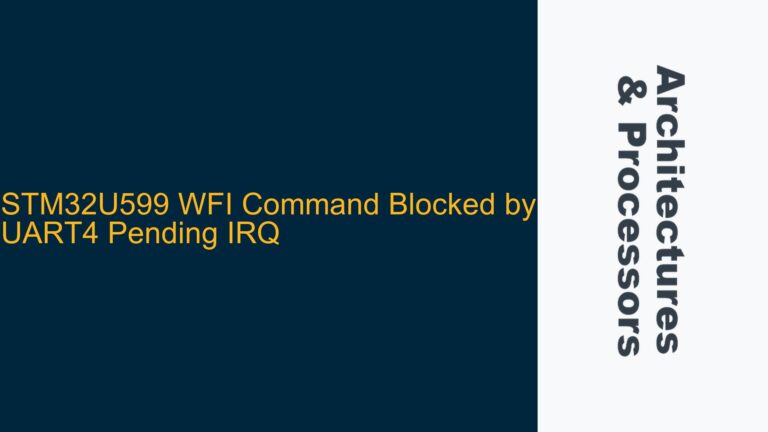Understanding ARM Cortex-M4 Load/Store Latency in Zero Wait State Memory
When working with ARM Cortex-M4 processors, one of the most critical performance metrics is the cycle count for load and store operations, especially when accessing zero wait state memory. Zero wait state memory, such as internal RAM, is typically designed to operate at the same or higher clock frequency than the processor core, theoretically allowing for single-cycle access. However, as observed in the provided scenario, load and store operations may still take more than one cycle, even under optimal conditions. This discrepancy can be attributed to several factors, including pipeline stalls, memory bus contention, and the inherent behavior of the ARM Cortex-M4 architecture.
The ARM Cortex-M4 processor, based on the ARMv7-M architecture, employs a 3-stage pipeline (Fetch, Decode, Execute) and a Harvard bus architecture, which separates instruction and data buses. While this design enhances performance by allowing simultaneous instruction fetches and data accesses, it also introduces complexities in cycle counting, particularly when dealing with load/store operations. The processor’s memory system, including the AHB (Advanced High-performance Bus) and the internal SRAM, plays a significant role in determining the actual cycle counts for these operations.
In the provided example, the test code involves a loop that performs load and store operations on an array in zero wait state memory. The generated assembly code reveals that each iteration of the loop consists of multiple load and store instructions, along with arithmetic and control flow operations. Despite the memory being zero wait state, the measured cycle count per instruction averages 2.6 cycles, which is higher than the expected single-cycle access. This behavior can be explained by examining the ARM Cortex-M4’s pipeline behavior, memory system, and the specific characteristics of the STM32F429ZITx microcontroller.
Pipeline Stalls, Memory Bus Contention, and Instruction Fetch Delays
One of the primary reasons for the increased cycle count in load/store operations is pipeline stalls. The ARM Cortex-M4’s 3-stage pipeline can experience stalls due to data dependencies, branch instructions, and memory access conflicts. In the provided assembly code, the loop contains multiple load and store instructions that access the same memory locations, potentially causing data hazards. For example, the instruction LDRH r3,[r4,r1,LSL #1] loads a halfword from memory into register r3, which is subsequently used in the next instruction STRH r3,[sp,#0x00]. If the memory access takes longer than expected due to bus contention or other factors, the pipeline may stall, waiting for the data to be available.
Memory bus contention is another significant factor. The ARM Cortex-M4’s Harvard architecture separates instruction and data buses, but both buses share the same memory resources. When multiple memory accesses occur simultaneously, such as an instruction fetch and a data load/store, the memory system must arbitrate between these requests, potentially introducing delays. In the provided example, the loop unrolling results in multiple load and store instructions being executed in close succession, increasing the likelihood of bus contention and subsequent cycle delays.
Instruction fetch delays can also contribute to the increased cycle count. The ARM Cortex-M4 fetches instructions from memory in 32-bit words, and if the instruction memory is not zero wait state, additional cycles may be required to fetch instructions. While the provided example assumes zero wait state memory for data accesses, the instruction memory may still introduce delays, especially if the processor is running at a high clock frequency or if the memory system is not optimized for single-cycle access.
Additionally, the ARM Cortex-M4’s memory system includes features such as write buffers and read buffers, which can affect cycle counts. Write buffers allow the processor to continue executing instructions while data is being written to memory, but if the buffer is full, the processor may stall until the write operation completes. Similarly, read buffers can prefetch data to reduce latency, but if the prefetch is incorrect or if the data is not available in the buffer, additional cycles may be required to fetch the data from memory.
Optimizing Load/Store Operations and Reducing Cycle Counts
To address the issue of increased cycle counts in load/store operations, several optimizations and best practices can be applied. First, minimizing data dependencies and pipeline stalls is crucial. This can be achieved by rearranging instructions to reduce the number of consecutive load/store operations and by using register renaming to avoid data hazards. For example, in the provided assembly code, the use of the stack pointer (sp) for temporary storage introduces additional load/store operations that could be avoided by using more registers or by optimizing the loop structure.
Second, reducing memory bus contention can significantly improve performance. This can be done by optimizing the memory layout to separate frequently accessed data from instruction memory, or by using DMA (Direct Memory Access) to offload data transfers from the processor. In the provided example, the loop accesses an array in internal RAM, which is typically zero wait state, but if the array is large or if other memory-intensive operations are occurring simultaneously, bus contention may still occur. Using DMA to transfer data between memory regions can free up the processor to execute other instructions, reducing the overall cycle count.
Third, ensuring that the instruction memory is optimized for single-cycle access is essential. This may involve configuring the memory system to prioritize instruction fetches or using cache memory to reduce instruction fetch latency. While the ARM Cortex-M4 does not include a cache, some microcontrollers, such as the STM32F429ZITx, include an optional instruction cache that can be enabled to improve performance. Enabling the instruction cache can reduce the number of cycles required to fetch instructions, particularly in loops with high instruction density.
Finally, understanding the specific characteristics of the microcontroller and its memory system is critical. The STM32F429ZITx microcontroller includes several memory regions, such as the CCM (Core Coupled Memory) RAM, which is designed for high-speed access with zero wait states. However, if the CCM RAM is not used or if other memory regions with wait states are accessed, the cycle count for load/store operations will increase. Ensuring that critical data is placed in zero wait state memory and that the memory system is configured for optimal performance can significantly reduce cycle counts.
In conclusion, while zero wait state memory is designed to allow single-cycle access for load and store operations, the actual cycle count on an ARM Cortex-M4 processor can be higher due to pipeline stalls, memory bus contention, and instruction fetch delays. By understanding the underlying architecture and memory system, and by applying optimizations such as minimizing data dependencies, reducing bus contention, and optimizing instruction memory access, it is possible to achieve closer to single-cycle performance for load/store operations in zero wait state memory.






